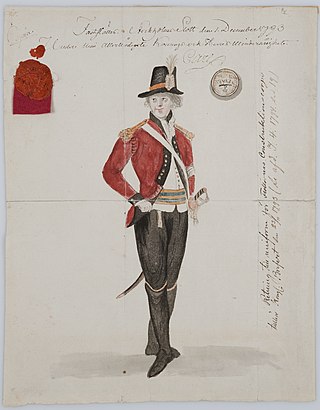
The Swedish Coastal Artillery has its origin in the Archipelago Artillery that was raised in 1866. The Coastal Artillery was formed from the Archipelago Artillery, the Marine Regiment and parts of the Artillery in 1902. Kustartilleriet, abbreviated KA, was an independent branch within the Swedish Navy until July 1, 2000, when the Swedish Coastal Artillery was disbanded and reorganised as the Swedish Amphibious Corps. The changed name and new structure were to reflect the new tasks that the old Coastal Artillery had moved to after the end of the Cold War and the demise of the Warsaw Pact.
An army division or division was during the 1900s in the Swedish Army a designation for a larger military unit, comprising two or more brigades, an artillery regiment, an engineer battalion, an anti-aircraft battalion, a signal battalion and a transport battalion. An arméfördelning corresponds to a division in many countries' armies, and it has been common to also use the word "division" in Swedish when referring to foreign rather than Swedish military units.
The Royal Swedish Naval Staff College was a Swedish Navy training establishment between 1898 and 1961, providing courses for naval officers. It was the home of the Swedish Navy's staff college, which provided advanced training for officers. It was located within the Stockholm garrison in Stockholm, Sweden.

Artillery Staff in the Swedish Army consisted of commanding officers from the artillery units and had the task of assisting the Master-General of the Ordnance and the Inspector of Artillery in all his activities related questions. It was active between 1807 and 1937.

Artillery and Engineering College was a Swedish Army training establishment active between 1878 and 1992, providing courses for artillery officers. It was located within the Stockholm Garrison in Stockholm, Sweden.

The Vaxholm Coastal Artillery Regiment, designation KA 1, was a Swedish Navy coastal artillery regiment of the Swedish Armed Forces which operated between 1902 and 2000. The unit was based at Rindö in the Stockholm archipelago in Uppland.
Ministry of Land Defence was in a broad sense, one of the eight ministries, in which the Swedish government administration was divided into. Its head was called Minister of War. The Ministry of Land Defence Department was established on 16 May 1840 and was merged with the Ministry for Naval Affairs into the newly established Ministry of Defence on 30 June 1920.
Karlskrona Artillery Corps was a coastal artillery unit of the Swedish Navy which operated between 1893 and 1902. The unit was based in Karlskrona in Blekinge.

The Surgeon-General of the Swedish Armed Forces is the highest-ranking medical officer of the Swedish Armed Forces. The Surgeon-General is responsible for the supervision of the Swedish Armed Forces, the Defence Materiel Administration, the Swedish Fortifications Agency and the National Defence Radio Establishment. This includes supervision in the areas of environment, health, nature, sewage, waste and chemicals.

The Vaxholm Artillery Corps was a corps-level artillery formation of the Swedish Army which operated between 1889 and 1901. The unit was based in Vaxholm in Uppland.
Vaxholm Grenadier Regiment, also I 26, was a Swedish Army infantry regiment that was active in various forms 1902–1927. The unit was based on Rindö in Vaxholm.
The Swedish Army Veterinary Corps was an administrative corps for veterinarians of the Swedish Army from 1887 to 1969. Its task was, in peace as well as in war, to provide army units etcetera with especially trained staff for veterinary positions in the army.
Underlöjtnant was the lowest officer rank in the Swedish Army from 1835 to 1937 instead of the previous ranks of fänrik and cornet. Fänrik was reintroduced in 1914 with the same position as underlöjtnant, from 1926 with lower position.
Blekinge Battalion, designated № 30, was an infantry unit of the Swedish Army that was active in various forms from 1887 to 1901. The unit was based in Ronneby.
The Swedish Naval Medical Officers’ Corps was an administrative corps established in 1902 for military physicians in the Swedish Navy and in the Swedish Coastal Artillery. The corps was amalgamated into the Medical Corps of the Swedish Armed Forces in 1969.
Karlsborg Artillery Regiment, designation A 9, was a Swedish Army artillery unit which operated between 1920 and 1937. The unit was based in Karlsborg Garrison in Karlsborg, Sweden.

Lieutenant General Herman Georg Waldemar Wrangel was a senior officer in the Swedish Coastal Artillery. He served as commanding officer of the Swedish Coastal Artillery for 15 years (1909–1924). Wrangel served as secretary, member and chairman of a number of committees and commissions. Wrangel was also a member of the Upper House of the Riksdag and a member of the Committee on Defence as well as of the Committee of Supply.
Flag captain was in the Swedish Navy a captain or commander who served as deputy to a fleet commander. During the 1900s, the flag captain served as chief of staff of Flaggen, the staff of the Chief of the Coastal Fleet.

The Swedish Navy Construction Corps was, during the years 1793–1868, a military organized corps in the Swedish Navy, primarily tasked with creating drawings and proposals related to naval materiel and overseeing work at the Swedish state shipyards.
The Swedish Navy Mechanical Corps was a Swedish Navy corps with naval engineers from 1814 to 1868. In 1816, it was stipulated that the organization responsible for shipbuilding work in Karlskrona, known as the Byggnadsstaten, would be transformed into a special unit called the Swedish Navy Mechanical Corps after the completion of this work. This corps ceased to exist with the organization of the Mariningenjörsstaten in 1868.













